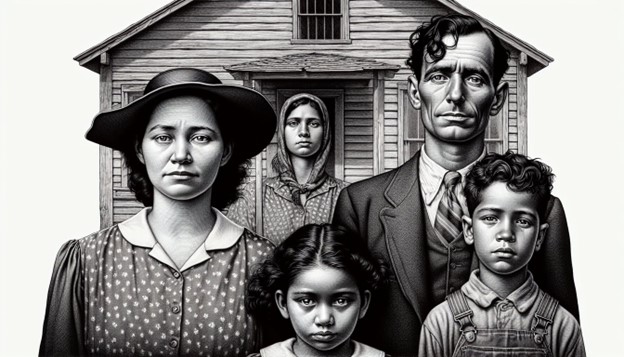As we peel back the layers of time, we uncover the somber realities that American families faced during the Great Depression. This era, marked by widespread economic downturn and uncertainty, reshaped the nation’s social fabric. The stories of endurance and adaptation during this period are not just a reflection of hardship but also a testament to the unyielding human spirit. One which offers a stark lesson for modern life.
The Daily Struggle for Survival
The crash of the stock market in 1929 heralded a decade of poverty, hunger, and profound uncertainty. American families, already weary from the exuberance of the Roaring Twenties, found themselves in a completely transformed world. Historians note the following hardships that became commonplace:
- Soaring unemployment rates, with a record of 25% at the peak of the Depression.
- Rapidly declining income levels, which plummeted by more than 50%.
- Massive loss of savings as banks failed, wiping out the financial security of millions.
- Agricultural prices fell dramatically, leading to widespread foreclosures and farm failures.
Familial Bonds in Times of Adversity
In the face of such despair, American families drew closer, prioritizing the welfare of the collective over individual desires. Familial bonds became the anchor that many clung to as they sought solace in shared experiences. The era was marked by:
- Communities come together to support one another through soup kitchens and cooperative efforts.
- Family units often expand to include extended relatives and friends in need.
- Children take on more responsibilities, sometimes leaving school to work and contribute to the family income.
Resilience in the Face of Desolation
Despite the relentless challenges, families found innovative ways to cope and even thrive under harsh conditions. They embraced a self-sufficiency that would define a generation, resorting to:
- Bartering services and goods in lieu of scarce cash.
- Developing home gardens, which provided sustenance and a small measure of self-reliance.
- Creating handmade clothes and household items, often repurposed from whatever materials were on hand.
- The grinding poverty and unemployment brought about an increase in criminal activities like bootlegging, robbing banks, and loan-sharking.
Reflection on The Boloney Trail
The “The Boloney Trail” series by Shelah A Johnson, with screenwriting by J R Santana, dives into this gritty reality with its inaugural book, “Perpetual Gloom.” It presents the Hornbeck family’s plight, entwining their story with historical events to give readers an immersive experience of the era. The website offers the first chapters and a TV script sample, hinting at a deeper exploration of the themes that dominated the lives of those who lived through the Depression. With upcoming releases like “Shattering Light,” the saga promises to continue its vivid portrayal of resilience amidst adversity.
Conclusion
The Great Depression left an indelible mark on American society, molding an entire generation through its trials. It underscored the importance of family, community, and the indomitable will to survive at any cost. As we reflect on this period through the lens of literature and history, we gain not only a deeper understanding but also an appreciation for the fortitude shown by those who endured one of the darkest chapters in American history.
Sharing is caring!




